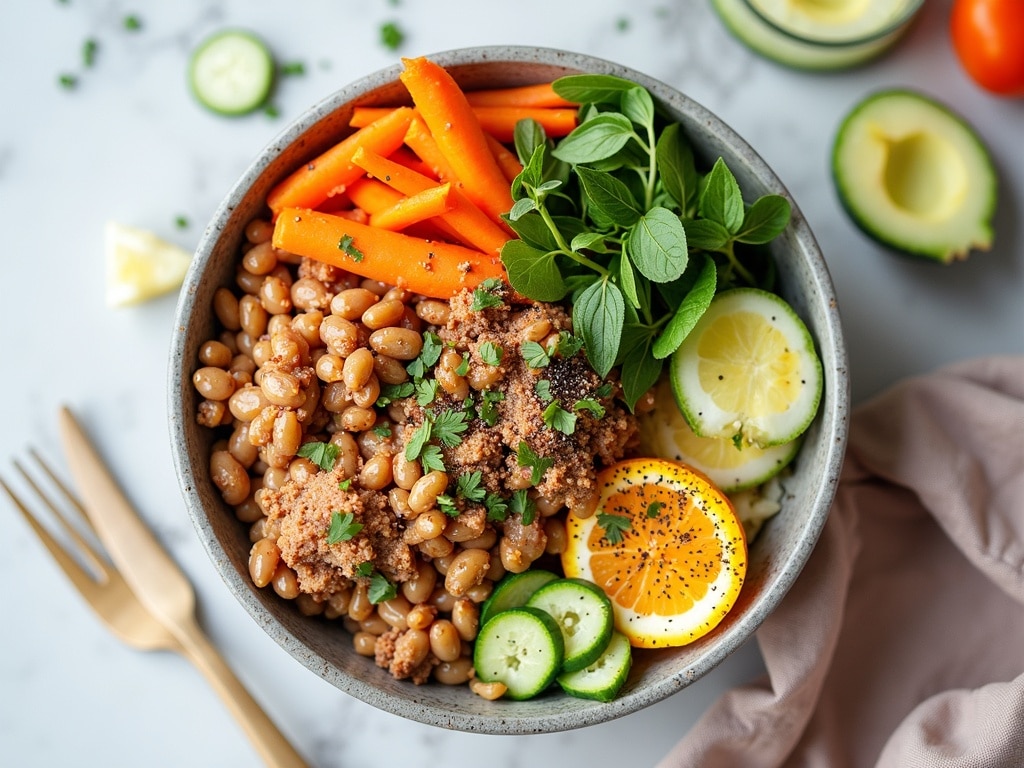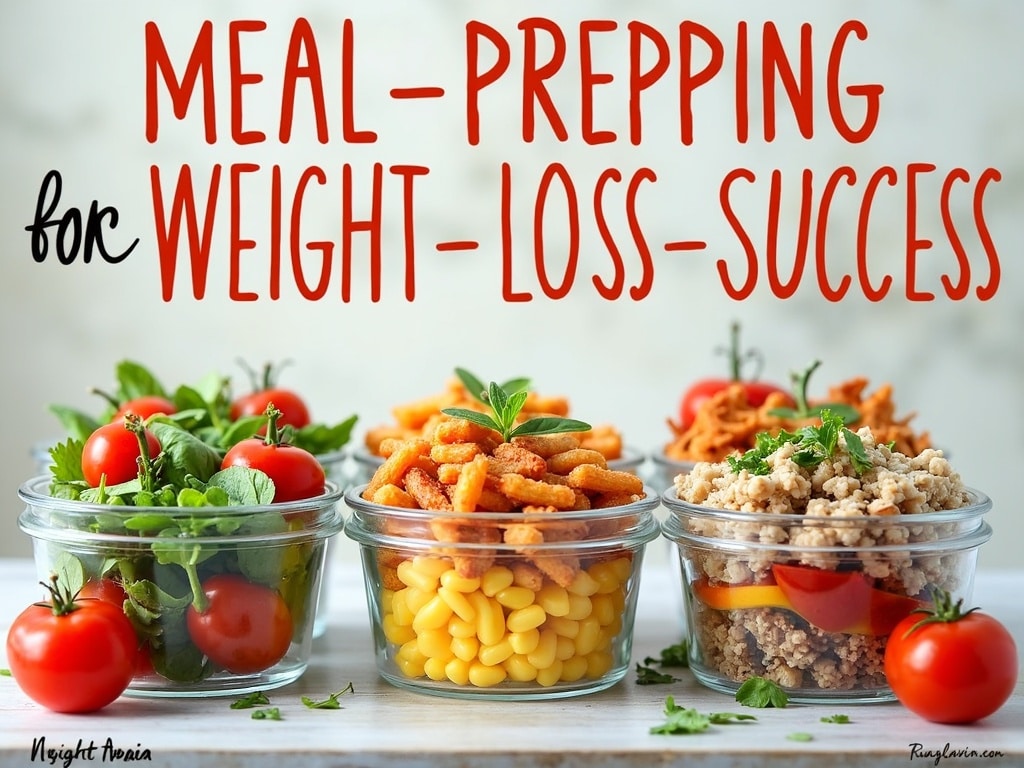Meal Prepping for Weight Loss Success: Your Complete Guide
Imagine a week where healthy eating isn't a daily battle, but a seamless transition from one delicious, portion-controlled meal to the next. No more last-minute takeout orders or impulsive trips to the vending machine. This vision can be your reality with the power of meal prepping. Far from being a mere trend, meal prepping is a strategic approach to nutrition that can significantly boost your weight loss efforts and overall well-being.
Why Meal Prepping is a Game Changer for Weight Loss
Weight loss isn't just about dieting; it's about creating sustainable habits. Meal prepping facilitates this by addressing several key challenges that often derail weight loss attempts:
- Reduced Calorie Intake: When you plan and prepare your meals in advance, you have complete control over ingredients and portion sizes. This allows you to consciously create meals that align with your caloric goals.
- Healthier Choices: Meal prepping encourages you to opt for whole, unprocessed foods. You're more likely to include plenty of fruits, vegetables, lean proteins, and whole grains when you're in control of the cooking process.
- Time Savings: Let’s face it, consistently cooking healthy meals from scratch every day is time-consuming. Meal prepping saves you valuable time during the week, freeing you up for exercise, relaxation, or other important activities.
- Reduced Food Waste: By planning your meals, you buy only what you need, minimizing food waste and saving money.
- Improved Portion Control: Pre-packaging your meals ensures you stick to appropriate portion sizes, a crucial factor in weight management.
Getting Started with Meal Prepping: A Step-by-Step Guide
Ready to embark on your meal prepping journey? Here's a practical guide to get you started:
1. Plan Your Meals
The cornerstone of successful meal prepping is effective planning.
- Choose Your Meals: Decide which meals you want to prep (breakfast, lunch, dinner, snacks). Consider your schedule and identify the meals where you're most likely to make unhealthy choices due to time constraints.
- Gather Recipes: Find healthy and delicious recipes that fit your dietary needs and preferences. Websites, cookbooks, and nutrition apps are excellent resources.
- Create a Meal Plan: Map out your meals for the week. Consider repeating meals to simplify the process, or opt for variety if that keeps you motivated.
- Make a Shopping List: Based on your meal plan, create a detailed shopping list to ensure you have all the necessary ingredients.
2. Smart Grocery Shopping
Armed with your shopping list, head to the grocery store.
- Stick to Your List: Avoid impulse purchases by sticking strictly to your list.
- Prioritize Produce: Load up on fresh fruits and vegetables. These should form the foundation of your healthy meals.
- Choose Lean Proteins: Select lean protein sources like chicken breast, fish, beans, lentils, or tofu.
- Opt for Whole Grains: Choose whole grains like brown rice, quinoa, or whole-wheat pasta over refined grains.
- Read Labels: Be mindful of added sugars, unhealthy fats, and excessive sodium.
3. Prep Like a Pro
Now comes the fun part: the actual meal preparation.
- Set Aside Time: Dedicate a few hours on a weekend or a day off to prep your meals.
- Prepare Ingredients: Chop vegetables, cook grains, grill or bake protein sources, and measure out spices and seasonings.
- Cook in Batches: Cook large batches of your chosen recipes to save time.
- Cool Completely: Allow your cooked food to cool completely before packaging it. This prevents condensation and keeps your meals fresh.
4. Packaging and Storage
Proper packaging and storage are crucial for maintaining the quality and safety of your prepped meals.
- Portion Control: Divide your meals into individual containers, ensuring each portion aligns with your calorie goals.
- Choose the Right Containers: Opt for BPA-free, airtight containers. Glass or plastic containers work well.
- Label Everything: Label each container with the meal name and the date it was prepared.
- Store Properly: Store your meals in the refrigerator at 40°F (4°C) or below. Generally, prepped meals will last for 3-4 days in the refrigerator. You can also freeze meals for longer storage (up to 1-2 months).

Delicious and Easy Meal Prep Ideas for Weight Loss
Need some inspiration? Here are a few simple and satisfying meal prep ideas:
Breakfast
- Overnight Oats: Combine rolled oats, chia seeds, milk (dairy or non-dairy), yogurt, and your favorite toppings (berries, nuts, seeds) in a jar. Let it sit overnight in the refrigerator.
- Egg Muffins: Whisk eggs with chopped vegetables (spinach, bell peppers, onions) and cheese. Pour into muffin tins and bake.
- Smoothie Packs: Combine frozen fruits, vegetables (spinach, kale), protein powder, and seeds in a resealable bag. Store in the freezer. When ready to enjoy, simply blend with liquid.
Lunch
- Salad Jars: Layer salad dressing, grains (quinoa, brown rice), vegetables, protein (grilled chicken, chickpeas), and leafy greens in a jar.
- Chicken and Veggie Bowls: Combine grilled chicken with roasted vegetables (broccoli, sweet potatoes, Brussels sprouts) and a healthy grain (brown rice, quinoa).
- Lentil Soup: Prepare a big batch of lentil soup and portion it into containers.
Dinner
- Sheet Pan Chicken and Veggies: Toss chicken breast and chopped vegetables (broccoli, carrots, sweet potatoes) with olive oil and spices. Roast on a sheet pan.
- Turkey Meatloaf with Roasted Vegetables: Prepare a healthy turkey meatloaf and serve with roasted vegetables.
- Salmon with Asparagus: Bake or grill salmon and serve with steamed or roasted asparagus.
Snacks
- Hard-Boiled Eggs: Boil a batch of eggs and store them in the refrigerator.
- Trail Mix: Combine nuts, seeds, and dried fruit.
- Cut Vegetables with Hummus: Prepare a container of cut vegetables (carrots, celery, bell peppers) and a small container of hummus.
Adapting Meal Prepping to Your Dietary Needs
Meal prepping is incredibly versatile and can be adapted to suit various dietary needs and preferences:
Vegetarian/Vegan
Focus on plant-based protein sources such as beans, lentils, tofu, tempeh, and quinoa. Incorporate plenty of vegetables and fruits into your meals. For vegetarian options, consider adding eggs or dairy products in moderation.
Gluten-Free
Be mindful of gluten-containing ingredients like wheat, barley, and rye. Opt for gluten-free grains like rice, quinoa, and oats. Always read labels carefully to ensure products are certified gluten-free.
Low-Carb
Focus on protein and healthy fats, while limiting carbohydrates. Choose non-starchy vegetables like leafy greens, broccoli, and cauliflower. Consider incorporating healthy fats like avocados, nuts, and seeds.
Allergies
If you have any allergies, carefully read labels and avoid ingredients that trigger your allergies. Consider prepping all your meals at home to minimize the risk of cross-contamination.
Tips for Long-Term Meal Prepping Success
Meal prepping is most effective when it becomes a sustainable habit. Here are some tips for long-term success:
- Start Small: Don't try to overhaul your entire diet overnight. Start by prepping just a few meals per week and gradually increase the frequency as you become more comfortable with the process.
- Find Recipes You Enjoy: Choose recipes that you genuinely enjoy eating. This will make meal prepping more enjoyable and sustainable.
- Vary Your Meals: Don't get stuck in a rut. Experiment with new recipes and flavors to keep things interesting.
- Invest in Quality Containers: Good-quality containers will keep your food fresh and prevent leaks.
- Clean as You Go: Wash dishes and clean up your workspace as you go to avoid a massive cleanup session at the end.
- Be Flexible: Life happens. Don't beat yourself up if you occasionally deviate from your meal plan. Just get back on track as soon as possible.
- Track Your Progress: Keep track of your weight loss progress to stay motivated.
Troubleshooting Common Meal Prepping Challenges
Even with the best planning, you might encounter some challenges along the way. Here's how to address them:
- Food Boredom: If you find yourself getting tired of the same meals, try different seasonings, sauces, and toppings. Experiment with new recipes and cuisines.
- Time Constraints: If you're short on time, focus on simple, quick-to-prepare meals. Use pre-cut vegetables and pre-cooked proteins to save time.
- Storage Issues: If you don't have enough refrigerator space, consider freezing some of your meals.
- Unexpected Events: If you have to eat out unexpectedly, try to make healthy choices. Opt for lean protein, vegetables, and whole grains.
The Mental Game of Meal Prepping
Meal prepping is not just about the food; it's also about your mindset. Approach it with a positive attitude and a commitment to your health goals. Visualize your success, celebrate your progress, and don't be afraid to ask for support. Remember that meal prepping is a journey, not a destination. With patience, consistency, and a little creativity, you can transform your eating habits and achieve your weight loss goals. So, grab your containers, sharpen your knives, and get ready to embark on a delicious and rewarding meal prepping adventure! Your healthier, happier self awaits.

